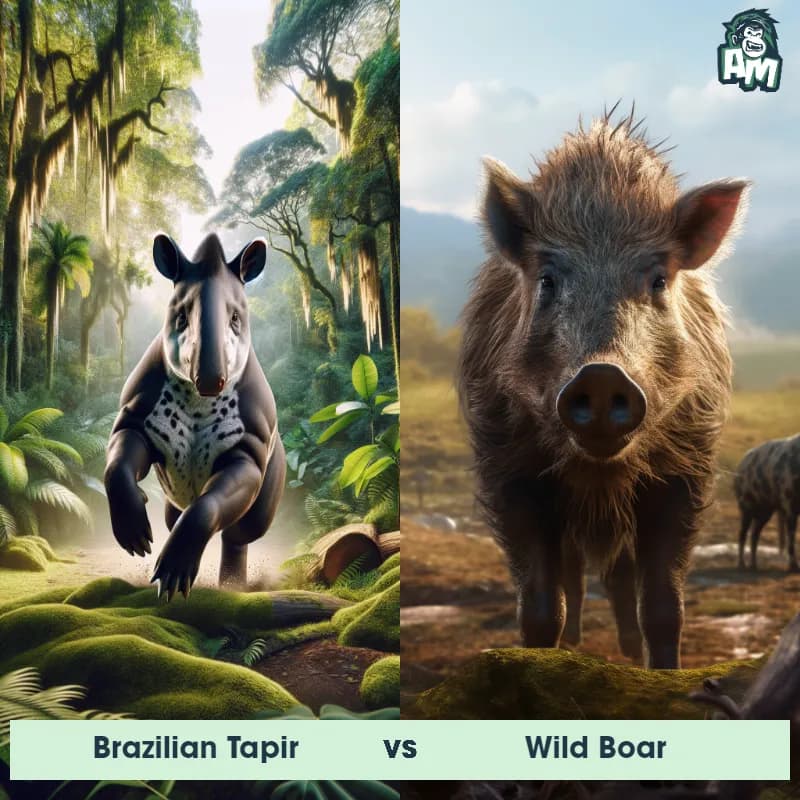Brazilian Tapir vs Wild BoarSee Who Wins

Welcome to this exciting matchup between the Brazilian Tapir and the Wild Boar! These two animals are known for their strength and agility, and we are in for a thrilling showdown tonight.
Contender 1: Brazilian Tapir
The Brazilian Tapir, also known as the South American Tapir, is a large herbivorous mammal found primarily in the tropical rainforests of Brazil, as well as other parts of South America. It possesses a distinctive appearance with a bulky body covered in short, coarse hair that ranges in color from dark brown to grayish black. This species has a unique prehensile proboscis-like snout, which is used to grasp vegetation and pluck leaves from trees. It has a stocky build, four sturdy legs, and a stubby tail. Brazilian Tapirs can reach an average length between 1.8 to 2.5 meters and weigh around 200 to 250 kilograms.
Fun Fact: Despite their seemingly bulky physique, Brazilian Tapirs are excellent swimmers, and they are able to stay submerged for long periods of time, using their snouts as snorkels to breathe in water while keeping the rest of their body underwater.
Contender 2: Wild Boar
The Wild Boar, also known as the feral pig, is a large, omnivorous mammal that can weigh up to 300 pounds and stand up to 3 feet tall at the shoulder. They have a distinctive snout and tusks, which they use for digging and defense. Wild Boars are found in many parts of the world, including Europe, Asia, and North America, and are known for their aggressive behavior and destructive impact on ecosystems.
Fun Fact: Wild Boars are excellent swimmers and can cross rivers and lakes with ease, making them difficult to contain or control.
Matchup Stats
| Brazilian Tapir | Wild Boar | |
|---|---|---|
| Size | Average length 1.8-2.5 meters (5.9-8.2 feet) | Up to 3 feet tall at the shoulder (91.44 cm), length up to 6 feet (1.83 m) |
| Weight | Around 200-250 kilograms (440-550 pounds) | Up to 300 pounds (136.08 kg) |
| Speed | 30mph (48km/h) | Speed: 30 mph (48.28 km/hr) |
| Key Strength | Powerful bite | Powerful tusks and aggressive behavior |
| Biggest Weakness | Limited mobility | Poor eyesight |
Current Votes
Brazilian Tapir vs Wild Boar
See Who Wins
View More Matches
Looking For More?
Similar Matches
Scientific Stats
| Brazilian Tapir | Wild Boar | |
|---|---|---|
| Scientific Name | Tapirus terrestris | Sus scrofa |
| Family | Tapiridae | Suidae |
| Habitat | Tropical rainforests | Forests, grasslands, and wetlands |
| Geography | Brazil, South America | Europe, Asia, and North America |
| Diet | Herbivorous | Omnivorous, eats roots, tubers, insects, small mammals, and carrion |
| Lifespan | 20 years - 30 years | 8 years - 18 years |
Key Differences between Brazilian Tapir and Wild Boar
- Ears: Brazilian tapirs have small, rounded ears that blend into their fur, while wild boars have large, pointed ears that are more noticeable.
- Shape: Tapirs have a sleek and streamlined body with a short, prehensile trunk, whereas wild boars have a bulkier, more muscular build with a snout that protrudes prominently from their faces.
- Size: The Brazilian tapir is typically larger than the wild boar, with males reaching weights of up to 700 pounds compared to the boar's maximum weight of around 300 pounds.
- Legs: The tapir's legs are long and slender, suited for walking and swimming, whereas wild boars have shorter, sturdier legs adapted for running and rooting in the ground.
- Tails: Tapirs have short tails that are barely visible, while wild boars sport distinct long, bushy tails that can be held erect.
- Coloration: Brazilian tapirs have dark brown fur with a white "saddle" marking on their backs, while wild boars have a more uniform reddish-brown or grayish coat.
































